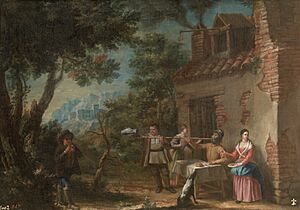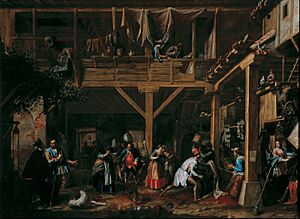Valero Iriarte facts for kids
Valero Iriarte (born around 1680 in Zaragoza, Spain, and died around 1753 in Madrid) was a Spanish painter. He was known for his beautiful portraits during the Baroque period, a style of art that used lots of drama and rich colors.
Life and Artworks
Valero Iriarte left his hometown when he was young and moved to Madrid, the capital of Spain. He quickly became a successful artist. In 1711, he painted a portrait of the Prince of Asturias, who was only four years old at the time. This painting was a big hit! Because of it, Valero Iriarte was allowed to visit the royal palace whenever he wanted.
He received many requests to paint for King Philip V and his wife, Queen Elisabeth Farnese. In 1720, he tried to get the important job of "Painter to the King," but he didn't get it. However, two years later, a group called the Council of Castile chose him to be an "Appraiser of Antique Paintings." This meant he was an expert who could judge the value of old artworks.
Artistic Style and Influences
Valero Iriarte learned to paint in the traditional Baroque style. But he also saw many paintings by French artists at the royal court. These French styles influenced his work. For example, Queen Elisabeth asked him to paint three scenes from the famous book Don Quixote. In these paintings, you can see the French influence, especially in the backgrounds. Two of these paintings are now in the Museo del Prado, a famous art museum in Spain.
Many of Valero Iriarte's portraits were done in a classic style, showing the influence of another Spanish painter named Juan Carreño de Miranda. But he also added new ideas he learned from French portrait painters like Jean Ranc and Michel-Ange Houasse. This mix of styles made his paintings very popular with both rich families and regular people. Some of his portraits, like those of doctors Martín Martínez and José Cervi, were even turned into engravings by Juan Bernabé Palomino. Engravings are like printed copies of artworks.
See also
 In Spanish: Valero Iriarte para niños
In Spanish: Valero Iriarte para niños



